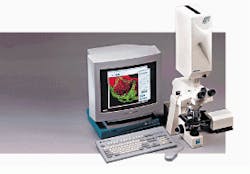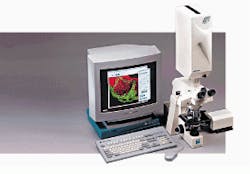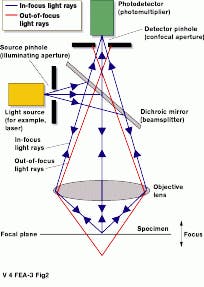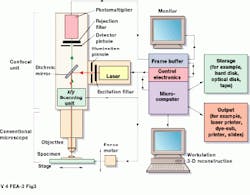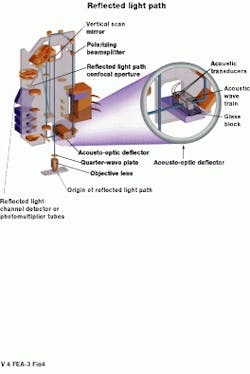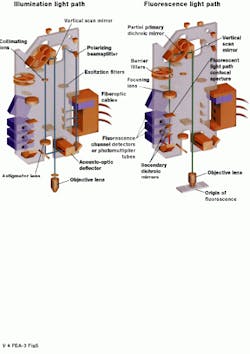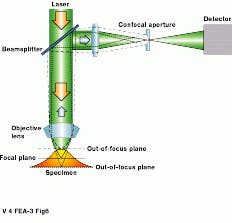Laser scanning improves specimen imaging
Laser scanning improves specimen imaging
By David Wilson
Laser scanning confocal microscopy (LSCM) is a valuable tool for obtaining high-resolution images and three-dimensional (3-D) reconstructions of various biological specimens. It is an advanced technology that is useful for studying thick specimens because it provides greater depth resolution than fluorescence-reflected light microscopy. In addition, LSCM provides the
improved extraction of both visual andquantitative information through the z dimension of a specimen.
In general, laser scanning confocal microscopes consist of a confocal unit that is attached to a conventional fluorescence microscope. For the most part, they follow common microscopy principles of operation, although the specifics of individual system designs can differ. According to Lance Ladic at the department of physiology at the University of British Columbia (Vancouver, BC, Canada), the basic principle of LSCM is to expand a laser light beam to gain optimal use of the optics in the objective lens.
Through an x-y deflection mechanism, the laser beam is turned into a scanning beam that is focused by an objective lens to a small spot onto a fluorescent specimen. The mixture of reflected light and emitted fluorescent light is captured by the same objective and, after conversion into a static beam by an x-y scanner device, is focused onto a photodetector (or photomultiplier) via a dichroic mirror (or beamsplitter). The reflected light is deviated by the dichroic mirror while the emitted fluorescent light passes through in the direction of a photomultiplier (see Fig. 1).
Because a confocal aperture (pinhole) is placed in front of the photomultiplier, the fluorescent light (not the reflected light) from points on the specimen that are not within the focal plane (called out-of-focus light) where the laser beam is focused is largely obstructed by the pinhole. In this approach, out-of-focus information (both above and below the focal plane) is greatly reduced. This process is important when dealing with thick specimens. The spot that is focused on the center of the pinhole is often referred to as the "confocal spot."
A two-dimensional (2-D) image of a small partial volume of the specimen centered around the focal plane (referred to as the optical section) is generated by performing a raster sweep of the specimen at that focal plane. As the laser scans across the specimen, the analog light signal, detected by the photomultiplier, is converted into a digital signal, thereby contributing to a pixel-based image displayed on a computer monitor attached to the microscope.
Pixel intensity
The relative intensity of the fluorescent light, emitted from the laser hit point, corresponds to the intensity of the resulting pixel in the image. The plane of focus (z plane) is selected by a computer-controlled motor that moves the microscope stage of the objective up and down (see Fig. 2). A 3-D reconstruction of a specimen can therefore be generated by stacking 2-D optical sections collected in series.
A confocal laser scanning imaging system developed by Noran Instruments (Middleton, WI), called OZ, can scan for high resolution at a slow speed to capture fine specimen details and also at a high speed--up to one image every 2 ms--to capture dynamic events. The system can be coupled to most research-type microscopes. In addition, its design allows the conversion between inverted and upright microscope configurations with minor light-path realignment.
Like other LSCM systems, the OZ comprises an x-y scanning unit, a laser, a scanning module and objective, a sample, a confocal aperture, and photodetectors. It incorporates "off-the-shelf" components, such as computers, motors, lasers, and photomultipliers, where feasible, to acquire images up to 1024 ¥ 960 pixels.
According to Ricardo Toledo of Noran, the OZ system differs slightly from typical LSCM systems (see Fig. 3). The OZ system enhances the z plane and lateral resolutions by illuminating the specimen one point at a time with a tightly focused point of laser light. An image of the specimen is therefore created one pixel at a time as the light spot is scanned across the specimen. By illuminating and simultaneously detecting from a single spot at a time rather than illuminating and detecting from the entire specimen, the OZ system ensures that each pixel represents detected fluorescence or reflected light from only the illuminated spot and not from adjacent regions.
Another difference stems from the design of the x-y scanning unit and the system software. In place of an established optical x-y scanning unit, the OZ system uses an electro-optical deflector that provides a 2-ms capture rate (see Fig. 4). This deflector also imitates the operation of a modulator in the sense that it can vary the intensity of the scanned beam.
Fast scanning
"Most confocal microscopes use mirrors to move the beams around," says Toledo. "We use an acousto-optical deflector (AOD), a solid-state device with no mechanical moving parts, to turn the OZ system into a fast scanning device." In the OZ system, one of the two mirrors in the x-y scanning unit is replaced by the deflector. "That means we have a very fast scan in the x direction, due to the AOD, along with the fast scan in the y direction," adds Toledo.
The AOD works through the interaction of light and sound. In operation, the laser beam is coupled to the scanning head of the acousto-optical deflector via an optical fiber. Moreover, a block of glass is joined to high-frequency acoustic transducers that act like speakers. The transducers send an acoustic wave train through the glass to induce local compressions and refractions in the material. These compressions and refractions result in periodic variations of the index of refractions of the glass so that it acts as a diffraction grating and diverts the optical beam. By varying the acoustic frequency, the period of the diffraction grating can be controlled, as well as the angle at which the beam is deflected. Dynamically changing the acoustic frequency sweeps the light smoothly across the horizontal axis.
Operation of the AOD is essentially limited only by the speed of sound across the crystal. Says Toledo, "That means the beam can be moved at rates of 480 images per second [at 256 ¥ 60 resolution]. Other systems can scan only a reduced image at about 5 to 10 images per second," says Toledo. "The faster the rate, the smaller the image that is acquired. Because the OZ system can acquire a full frame image at a video rate of 30 images per second [at 512 ¥ 512 resolution], the user does not see any flickering of the image," he states.
After the beam emerges from the acousto-optic deflector, it is then reconstituted into a Gaussian beam, which is then imaged or reflected into a second scanner. The second or y scanner is a slower moving device that uses a traditional galvanometer-driven mirror. When the fully x-y scanned beam emerges from the second scanning device, it is then directed onto a focusing lens that can couple the scanner to virtually all commercial microscopes, such as those from Nikon, Zeiss, Leica, and Olympus.
The return light path deviates slightly from standard methods (see Fig. 5). The light from the sample is collected by the microscope objective and coupled to the OZ scanner through the same lens that is initially used to illuminate the sample. It is then descanned by the second of two scanners, which is a conventional mirror, and is then passed into a dichroic separation filter. In turn, the light is next imaged onto the confocal aperture that provides the confocality of the system (see Fig. 6).
To process and analyze the imaging data, the OZ system uses a Silicon Graphics` workstation. Consequently, the OZ system does not need a frame-grabber board, as PC-based systems do. Instead, data are directly digitized from the photomultiplier output and directed into workstation memory via avideo connection.
In terms of control electronics, the OZ system uses an off-the-shelf, 486-based PC-style controller board that interfaces to the workstation. Aside from controlling the operation of the laser and the focus motor, the board is also partially responsible for controlling certain image-processing functions, such as signal averaging and signal integration. However, the control electronics are transparent to users because of the direct interface to the workstation.
The system software suite has been developed in-house. "Our sophisticated software," says Toledo, "not only includes the capture of digital video, but also includes an extensive image-analysis package called Intervision." One module in the Intervision software suite targets deconvolution, a method of deblurring images. It includes several custom 2-D and 3-D deconvolution algorithms that operate faster and require less processing than conventional software.
In the "blind" deconvolution package, multiple point-spread functions are estimated from the actual image of the specimen. When derived from the specimen, the point-spread-function estimates incorporate variations that occur at different depths within the specimen, as well as those caused by specific properties of the specimen, such as differences in the refractive index of the specimen along the light path.
During the past few years, the issue of whether a confocal image is better than a deconvolved image has been a hotly contested issue in the vision industry. "We maintain that a combination of the two is the best," says Toledo. "Of course, deconvolution requires some processing, but if the users have an acceptable set of images, they can use custom software to provide extra resolution," he adds.
Three-dimensional imaging in real time allows LSCM systems to capture the rapid changes in ion concentrations or fluorophore distributions throughout an entire cell or tissue slice, rather than through a single optical plane. To obtain such 3-D imaging, the OZ system can be fitted with a piezoelectric motor. The motor drives the objective lens, allowing the acquisition of as many as 15 optical image slices per second. This rapid acquisition rate helps to minimize the exposure of photosensitive specimens and fluorochromes to laser illumination.
DAVID WILSON is a science writer in London, England.
FIGURE 1. With custom software, the OZ confocal laser scanning imaging system can scan at high resolution with a slow scanning speed to capture fine specimen details. It can also operate at a high scanning speed--up to one image every 2 ms--to capture dynamic events. When coupled to most popular research microscopes, the system can convert between inverted and upright microscope configurations without light path realignment. System software enables 3-D rendering capabilities and ratiometric analysis for single- and dual-wavelength ion indicators. Applications range from rapid ion kinetics to distribution of gene expression markers labeled with green fluorescence protein or other fluorophores.
FIGURE 2. In the optics section of an LSCM, the mixture of reflected light and emitted fluorescent light is captured by the same objective lens and, after conversion into a static beam by an x-y scanner device, is focused onto a photodetector via a dichroic mirror. The reflected light is deviated by the dichroic mirror while the emitted fluorescent light passes through in the direction of the photodetector.
FIGURE 3. A typical LSCM system includes either a Windows-based personal computer or a UNIX-based workstation. Images are captured by a photodetector, fed to a computer for processing, and then displayed on a monitor. However, to increase system speed, the OZ system couples the digitized output from the photodetector directly into the memory of a Silicon Graphics` workstation.
FIGURE 4. In the reflected light path of the OZ system, an acousto-optic deflector scans received light in the horizontal direction. An adjacent galvanometer-driven mirror scans a point of light in the vertical direction.
FIGURE 5. The OZ confocal laser-scanning-microscopy system can be configured with as many as five light channels: three fluorescent (via three input fibers), one reflected, and one illumination. It can acquire images up to 1024 ¥ 960 pixels to maximize spatial resolution and discrimination of the fine details in the images. With its associated custom software suite, the system provides full 24-bit multilabel displays for image planes and image volumes.
FIGURE 6. The confocal aperture, an opening for light returning from a specimen, is strategically placed in front of the detector within the returning light path so that only light emanating from the focal plane within the specimen is focused at the aperture. Only this focused light can pass through the aperture and reach the detector. Any light emanating from planes above or below the focal plane within the specimen, which would add out-of-focus blur or haze to an image, is too divergent at the aperture to pass through the opening.
